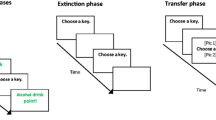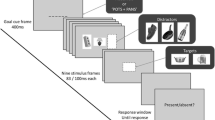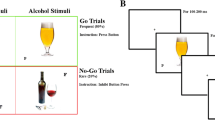Abstract
Background
Drug and alcohol users have an ‘attentional bias’ for substance-related cues, which is likely to reflect the incentive-motivational properties of those cues. Furthermore, administration of an alcohol preload increases attentional bias for alcohol and tobacco-related cues in heavy drinkers and tobacco smokers, respectively. The present study investigated attentional bias for cocaine cues in cocaine users and non-users following administration of either alcohol or placebo.
Method
Thirty-two regular cocaine users and 40 non-users took part. Participants were administered alcohol or placebo, and administration was double blind. After drink administration, a Visual Probe task and Modified Stroop task were used to assess attentional bias. Subjective craving and alcohol outcome expectancies were also measured.
Results
There was a significant interaction between group and drink type on the visual probe task indicating that cocaine users who had received alcohol had increased attentional bias for cocaine pictures compared to non-users and cocaine users who received placebo. The cocaine Stroop revealed no differences between cocaine users and non-users, and no effects of alcohol in either group.
Conclusions
Alcohol preload in regular cocaine users increases attentional bias for cocaine cues. However, cocaine users who received placebo did not show attentional bias for cocaine stimuli. Future research should investigate the effects of alcohol preload on attentional bias in cocaine-dependent individuals.


Similar content being viewed by others
Notes
Only two participants made any errors on this task so errors were not analysed separately.
References
Aarons GA, Brown SA, Stice E, Coe MT (2001) Psychometric evaluation of the marijuana and stimulant effect expectancy questionnaires for adolescents. Addict Behav 26:219–236
Biala G, Budzynska B (2008) Calcium-dependent mechanisms of the reinstatement of nicotine-conditioned place preference by drug priming in rats. Pharmacol Biochem Behav 89:116–125
Boileau I, Assaad J, Pihl RO, Benkelfat C, Leyton M, Diksic M, Tremblay RE, Dahger A (2003) Alcohol promotes dopamine release in the human nucleus accumbens. Synapse 49:226–231
Bradley BP, Mogg K, Wright T, Field M (2003) Attentional bias in drug dependence: vigilance for cigarette-related cues in smokers. Psychol Addict Behav 17:66–72
Cox WM, Yeates GN, Regan CM (1999) Effects of alcohol cues on cognitive processing in heavy and light drinkers. Drug Alcohol depend 55:85–89
Cox WM, Brown MA, Rowlands LJ (2003) The effects of alcohol cue exposure on non-dependent drinkers’ attentional bias for alcohol-related stimuli. Alcohol Alcohol 38:45–49
Cox WM, Fadardi JS, Pothos EM (2006) The addiction Stroop test: theoretical considerations and procedural recommendations. Psychol Bull 132:443–476
Duka T, Townshend JM (2004) The priming effect of alcohol pre-load on attentional bias to alcohol-related stimuli. Psychopharmacology 176:353–362
European Monitoring Centre for Drugs and Drug Addiction (2008) 2008 Annual report: the state of the drugs problem in Europe. EMCDDA, Lisbon
Field M, Mogg K, Bradley BP (2004a) Cognitive bias and drug craving in recreational cannabis users. Drug Alcohol Depend 74:105–111
Field M, Mogg K, Bradley BP (2004b) Eye movements to smoking-related cues: effects of nicotine deprivation. Psychopharmacology 173:116–123
Field M, Mogg K, Bradley BP (2005) Alcohol increases cognitive biases for smoking cues in smokers. Psychopharmacology 180:63–72
Field M (2006) Attentional biases in drug abuse and addiction: cognitive mechanisms, causes, consequences, and implications. In: Munafo MR, Albery IP (eds) Cognition and addiction. Oxford University Press, Oxford
Field M, Rush M, Cole J, Goudie A (2007) The smoking Stroop and delay discounting in smokers: effects of environmental smoking cues. J Psychopharmacol 21:603–610
Field M, Cox WM (2008) Attentional bias in addictive behaviors: a review of its development, causes, and consequences. Drug Alcohol Depend 97:1–20
Field M, Schoenmakers T, Wiers RW (2008) Cognitive processes in alcohol binges: a review and research agenda. Curr Drug Abuse Rev 1:263–279
Field M, Munafo MR, Franken IHA (2009) A meta-analytic investigation of the relationship between attentional bias and subjective craving in substance abuse. Psychol Bull 135:589–607
Fox E, Russo R, Bowles R, Dutton K (2001) Do threatening stimuli draw or hold visual attention in subclinical anxiety? J Exp Psychol Gen 130:681–700
Franken IHA, Kroon LY, Wiers RW, Jansen A (2000a) Selective cognitive processing of drug cues in heroin dependence. J Psychopharmacol 14:395–400
Franken IHA, Kroon LY, Hendriks VM (2000b) Influence of individual differences in craving and obsessive cocaine thoughts on attentional processes in cocaine abuse patients. Addict Behav 25:99–102
Franken IHA (2003) Drug craving and addiction: integrating psychological and neuropsychopharmacological approaches. Prog Neuropsychopharmacol Biol Psychiatry 27:563–579
Fromme K, Stroot E, Kaplan D (1993) Comprehensive effects of alcohol: development and psychometric assessment of a new expectancy questionnaire. Psychol Assess 5:19–26
Gossop M, Manning V, Ridge G (2006) Concurrent use and order of use of cocaine and alcohol: behavioural differences between users of crack cocaine and cocaine powder. Addiction 101:1292–1298
Haertzen CA (1974) An overview of addiction research center inventory scales: an appendix and manual of scales. National Institute on Drug Abuse.
Harris DS, Everhart ET, Mendelson J, Jones RT (2003) The pharmacology of cocaethylene in humans following cocaine and ethanol administration. Drug Alcohol Depend 72:169–182
Hearn WL, Rose S, Wagner J, Ciarleglio A, Mash DC (1991) Cocaethylene is more potent than cocaine in mediating lethality. Pharmacol Biochem Behav 39:531–533
Herrero MJ, Domingo-Salvany A, Torrens M, Brugal MT (2008) Psychiatric comorbidity in young cocaine users: induced versus independent disorders. Addiction 103:284–293
Hester R, Dixon V, Garavan H (2006) A consistent attentional bias for drug-related material in active cocaine users across word and picture versions of the emotional Stroop task. Drug Alcohol Depend 81:251–257
Hoare J (2009) Drug misuse declared: findings from the 2008/09 British crime survey. Home Office, London
Kypri K, Paschall MJ, Langley J, Baxter J, Cashell-Smith M, Bourdeau B (2009) Drinking and alcohol-related harm among New Zealand university students: findings from a national web-based survey. Alcohol Clin Exp Res 33:307–314
Love A, James D, Willner P (1998) A comparison of two alcohol craving questionnaires. Addiction 93:1091–1102
Lubman DI, Peters LA, Mogg K, Bradley BP, Deakin JFW (2000) Attentional bias for drug cues in opiate dependence. Psychol Med 30:169–175
MacLeod C, Mathews A, Tata P (1986) Attentional bias in emotional disorders. J Abnorm Psychol 95:15–20
Matthews G, Jones DM, Chamberlain AG (1990) Refining the measurement of mood: the UWIST mood adjective checklist. Br J Psychol 81:17–42
Mogg K, Bradley BP, Williams R (1995) Attentional bias in anxiety and depression: the role of awareness. Br J Clin Psychol 34:17–36
Mogg K, Bradley BP, Field M, De Houwer J (2003) Eye movements to smoking-related pictures in smokers: relationship between attentional biases and implicit and explicit measures of stimulus valence. Addiction 98:825–836
Mogg K, Philippot P, Bradley BP (2004) Selective attention to angry faces in clinical social phobia. J Abnorm Psychol 113:160–165
Office for National Statistics (2008) Deaths related to drug poisoning in England and Wales, 2003–07. Health statistics quarterly 39 (Autumn 2008). Office for National Statistics, London
Pennings EJM, Leccese AP, de Wolff FA (2002) Effects of concurrent use of alcohol and cocaine. Addiction 97:773–783
Posner MI, Snyder CR, Davidson BJ (1980) Attention and the detection of signals. J Exp Psychol 109:160–174
Robinson TE, Berridge KC (1993) The neural basis of drug craving: an incentive-sensitization theory of addiction. Brain Res Rev 18:247–291
Ryan F (2002) Detected, selected, and sometimes neglected: cognitive processing of cues in addiction. Exp Clin Psychopharmacol 10:67–76
Rosse RB, Johri S, Kendrick K, Hess AL, Alim TN, Miller M et al (1997) Preattentive and attentive eye movements during visual scanning of a cocaine cue: correlation with intensity of cocaine cravings. J Neuropsychiatry Clin Neurosci 9:91–93
Saunders JB, Aasland OG, Babor TF, dela Fuente JR, Grant M (1993) Development of the Alcohol Use disorders Identification test (AUDIT): WHO collaborative project on early detection of persons with harmful alcohol consumption-II. Addiction 88:791–804
Schoenmakers T, Wiers RW, Field M (2008) Effects of a low dose of alcohol on cognitive biases and craving in heavy drinkers. Psychopharmacology 197:169–178
Schulze D, Jones BT (1999) The effects of alcohol cues and an alcohol priming dose on a multi- factorial measure of subjective cue reactivity in social drinkers. Psychopharmacology 145:452–4
Shields AL, Guttmannova K, Caruso JC (2004) An examination of the factor structure of the alcohol use disorders identification test in two high-risk samples. Subst Use Misuse 39:1161–1182
Smith MA, Greene-Naples JL, Felder JN, Iordanou JC, Lyle MA, Walker KL (2009) The effects of repeated opioid administration on locomotor activity: II. Unidirectional cross-sensitization to cocaine. J Pharmacol Exp Ther 330:476–486
Sobel BFX, Riley AL (1999) The interaction of cocaethylene and cocaine and of cocaethylene and alcohol on schedule-controlled responding in rats. Psychopharmacology 145:153–161
Sumnall HR, Tyler E, Wagstaff GF, Cole JC (2004) A behavioural economic analysis of alcohol, amphetamine, cocaine and ecstasy purchases by polysubstance misusers. Drug Alcohol Depend 76:93–99
Thomas BA, McCambridge J (2008) Comparative psychometric study of a range of hazardous drinking measures online in a youth population. Drug Alcohol Depend 96:121–127
Tiffany ST, Singleton E, Haertzen CA, Henningfield JE (1993) The development of a cocaine craving questionnaire. Drug Alcohol Depend 34:19–28
Townshend JM, Duka T (2001) Attentional bias associated with alcohol cues: differences between heavy and occasional social drinkers. Psychopharmacology 157:67–74
Waters AJ, Shiffman S, Bradley BP, Mogg K (2003) Attentional shifts to smoking cues in smokers. Addiction 98:1409–1417
Author information
Authors and Affiliations
Corresponding author
Rights and permissions
About this article
Cite this article
Montgomery, C., Field, M., Atkinson, A.M. et al. Effects of alcohol preload on attentional bias towards cocaine-related cues. Psychopharmacology 210, 365–375 (2010). https://doi.org/10.1007/s00213-010-1830-y
Received:
Accepted:
Published:
Issue Date:
DOI: https://doi.org/10.1007/s00213-010-1830-y




